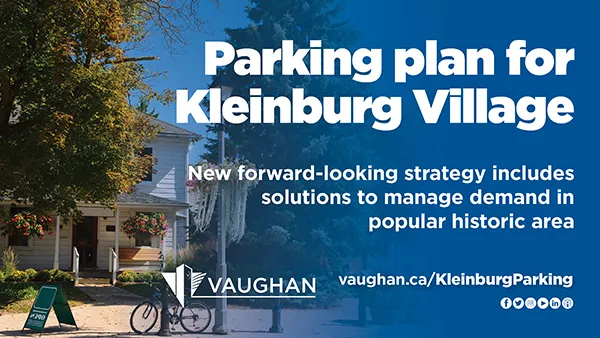Parking plan for Kleinburg Village
New forward-looking strategy includes solutions to manage demand in popular historic area
Vaughan’s Kleinburg Village is known for its historic charm, lush parks and green spaces, variety of shopping and dining opportunities as well as venues and tourist attractions that include schools, libraries and art galleries. As its popularity grows, so, too, does the demand for parking. The City of Vaughan has recently completed the Kleinburg Parking Strategy Study (PDF) to help address these parking needs.
To begin developing a plan for parking in Kleinburg, the City’s Development Engineering department – supported by Vaughan Council and the Kleinburg Business Improvement Area – first initiated the Kleinburg Parking Strategy Review in August 2019. Now complete, this forward-looking strategy assesses the current parking conditions, recommends implementable parking management solutions and identifies sustainable sources of funding or financing alternatives through immediate, short-, medium- and long-term solutions.
A current assessment of the Village reflects frustration in finding parking, traffic operations, pedestrian safety and other parking nuances of certain businesses or destinations. There is also a lack of on-street parking, an inadequate signage and wayfinding system and uncertainty about where parking is permitted – these factors have resulted in a reoccurrence of illegal parking. The strategy identifies opportunities to appropriately manage parking constraints, ensure parking plans are included in further development projects and transition the Village to a more pedestrian-oriented space.
Currently, the City is delivering on several immediate- to short-term recommendations, which were approved by Vaughan Council in October. To be implemented within the next one to three years, solutions include:
- delivering critical short-term infrastructure improvements to signage, wayfinding and parking through the Islington Avenue Streetscape Construction Project.
- updating the cash-in-lieu policy which was introduced to reduce or waive the required number of on-site parking spaces, as mandated by the City’s Parking By-law and Zoning By-law.
- exploring parking partnerships with private property owners, including the Doctor’s House restaurant to provide public parking, and the local Canada Post branch to provide community mailboxes.
Additional short-, mid- and long-term strategies proposed in the report include:
- improving the accessibility of public parking through centralized parking, wayfinding and signage changes, and streetscape modifications.
- promoting underused parking areas, given almost the entire Village is within walking distance of any internal destination or location.
- updating or amending policies to address development-related concerns.
- investigating transitioning the Village to a more pedestrian-oriented space in the long-term, subject to further monitoring and review.
- encouraging a reduction in vehicular through-traffic in the Village and encouraging sustainable transportation options like public transportation, biking or walking.
The study was completed in two phases, both incorporating comprehensive public and stakeholder engagement opportunities, including online feedback surveys, digital presentations, and in-person and virtual information sessions. As part of Phase 1, the team also conducted several on-street and off-street parking surveys, such as turnover and duration-of-stay surveys, to understand the daily and seasonal variations in parking demand. The team also observed and assessed current pedestrian activities and bicycle parking demand relative to available infrastructure. In Phase 2, the team developed and evaluated alternative solutions to address existing and future parking needs, such as improving parking space management to increase the available parking supply and identifying sustainable sources of funding or financing alternatives.
In addition to capturing parking needs and documenting potential solutions, an implementation plan was also developed as part of the final report. This plan provides a guiding framework for staff and will assist Council in making informed budget decisions regarding this project. Further, the study’s findings and recommendations will help to enhance Kleinburg Village and also align with core priorities outlined in the City’s 2018-2022 Term of Council Service Excellence Strategic Plan, including Transportation and Mobility and City Building.
-30-

